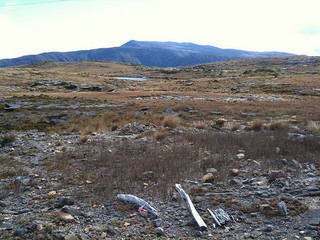
Denniston Plateau – Image trailsource.com
The Denniston Plateau deal shows that National and the mining industry have learned their lesson from their last attempt to mine on conservation land.
Sure, it was a tad cynical of the Government to make this latest decision the day before the rules on public notification changed. However, the basic thrust of the plan is sound: the money generated from harming one part of the conservation estate can be used to make the rest better.
Overall, if the Government’s plan comes off, we will be left with a better conservation estate. In a time of limited budgets and pressing conservation priorities, such deals make sense.
But for those who don’t accept degradation of the environment at any price – welcome to the wilderness of irrelevance, where have you been since humankind emerged 200,000 years ago. The issue is how the hell do we minimise such degradation given humankind’s insatiable desire for material aggrandisement.
“Stop” is not an alternative that society is ready to accept.
For those of you who missed the guts of the deal, here it is:
- The plan is for an open-cast mine (yes, that means it would be visible, an eyesore even – albeit safer than Pike River) on 106ha of the Denniston Plateau, around 5 per cent of that particular park area.
- In exchange, the mining company is offering $22 million to improve the DoC estate elsewhere. The plan is to use that money on pest eradication in the Kahurangi National Park (home to the Heaphy Track).
To those who oppose this idea of offsets our question is “what is your price?”. The concept of offsetting holds that damaging our natural capital in one area can be compensated by improving it in another. If the mining is lucrative enough, presumably this would be an overall win for the DoC estate and conservation generally, not to mention providing jobs for the people of the West Coast.
The idea of offsets has been around for a while – remember that once-was-credible Solid Energy company that set out to mine lignite in Southland, and offered environmental offsets for the carbon emissions of the coal by planting trees or buying carbon credits.
While conservationists naturally don’t like the concept of having to put a price on our natural capital, the reality is jobs and incomes matter, and if the govern-ment of the day feels extractive industries are the best way to provide those, the challenge for those who disagree is to prove otherwise. Until they can, extractive industries will continue to grow.
Our only regret with the Denniston decision is that DoC didn’t manage to get $50 million as the offset. That would have funded the whole of the Stewart Island pest eradication and we’d have a great time proving which project – the mine or the World Heritage site – was the better boon to jobs and incomes!
We need to show that the jobs and income consequences of protecting, enhancing and monetising our natural capital are greater than those of digging the next mine. That’s the challenge.
Of course, this offset concept doesn’t work when the environment destroyed by mining is irreplaceable.
Some would say that’s always the case – they need to come up with how we decimate the world’s population so consumerism stops. Others would say we’ve destroyed enough, stop now – they need to tell us how to allocate what we’ve got across a rising population, or at least who is going to go without what. Good luck at the ballot box with that one.
So how unique is the Denniston Plateau compared to the rest of New Zealand? Those who make claims of the plateau being “priceless” or “irreplaceable” either have no skin in the game (nothing to lose) or find making trade-offs intellectually impossible, so simply advocate abolition of extraction.
Easy for outsiders to oppose something in principle and not get sullied with the choices faced in the real world by those who have to actually go without as a consequence. We suggest they will need to keep chaining themselves to trees to make their point. When they come down they may find that everyone else has left the country in search of a job.
The real issue is that DOC and the New Zealand public need better information to make these sorts of choices. We need ways of evaluating the impacts of deals like this.
What is a fair compensation package for mining the plateau? What impact on our species can we expect from mining, and what conservation dividend would we get from the $22 million? These are the real questions to ask.
Looking forward, most DOC land is in the unused highlands. Would some of that be an appropriate trade-off to make Stewart Island or Great Barrier predator free for instance?
This sort of information would also help decide, to the best of our knowledge, what New Zealand’s conservation priorities are and what sacrifices could be reasonably made to achieve them.
DOC is the curator for around one third of New Zealand’s land. It is charged with saving New Zealand’s endangered species at the same time. The plain fact is that the department can’t hope to achieve this without making the most of the assets under its jurisdiction.
If it blanket-bans extractive industries in the conservation estate that we want, we either accept a lower standard of material well-being or we get smarter about protecting, enhancing and monetising that conservation estate. Locking it up is not the answer, because the predators and the alien plants are certainly on the march.
That is why in coming weeks we will be talking about imposing a levy on foreign tourists accessing these treasures.

